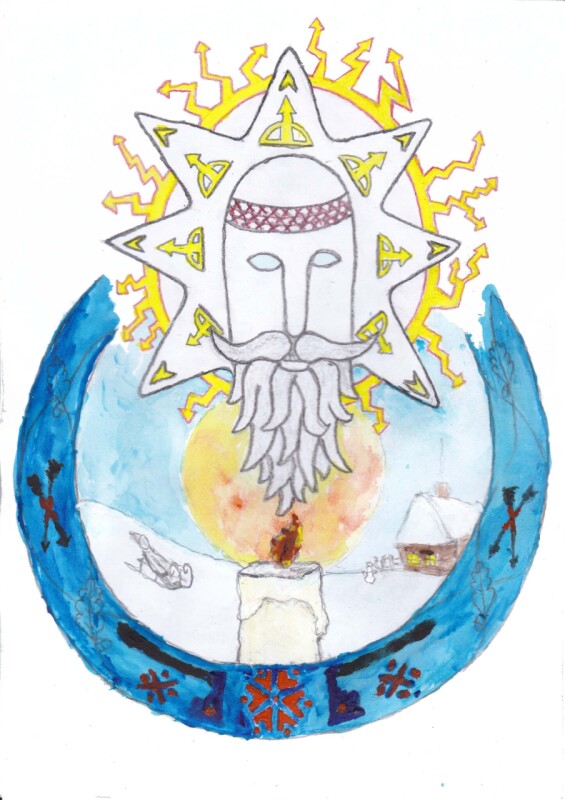We already welcomed the New Sun in the form of Koliada during the winter solstice. The old year ended, the new one began and our three kings Svarog, Perún and Veles came to sanctify it and thus began the period that our ancestors called "Mjasopust" or also "Maselnice" or "Fašiangy".
We begin to perceive the lengthening day when winter meets summer and there is a holiday called "Sretenie" known under the name "Groundhog-Hromnice".
So, Shrovetide begins with the Feast of the three kings, ends with Groundhog Day, and ends with „Veles Day“ and „Ash Wednesday“. At this time, it is obvious to everyone that the season of winter and cold is peaking and approaching its end. However, our ancestors also ran out of cultivated food supplies at this time, and so in this period comes the time for kabattoir.
Thanks to the winter's freedom from farm work and plenty of meaty food, it is a time of games, fun and festivities, as well as weddings.
It is the time when engaged people become married, but not only that. During Carnival, boys became bachelors and bachelors became men, girls became virgins, and virgins became women. In the same way, there was a ceremonial procedure among craftsmen, when apprentices became journeymen, journeymen became masters. Masked parades and processions are also typical for this period.
Many proverbs are associated with the Groundhog Day, which reflect the experiences of our ancestors, unfortunately, because of our behavior, the world has changed a lot and many of them are losing their meaning and their prophetic meaning: If there is frost on Groundhog Day, there will be fifty times more; When there are dunghills on Groundhog Day, there is no more winter; They passed Hromnice, the end of the sleigh; If the groundhog bird drinks from the rut, it will freeze in March; When it's nice on Groundhog Day, the bear turns to the other side; If even as much snow falls on Groundhog Day as you see on a black cow, it will be a fertile year; If the sun shines on Groundhog Day, there will be no abundance of rye or wheat; If long icicles hung from the roofs, it meant that long hemp would grow;
But what hasn't stopped paying is: On Groundhog Day an hour moree!
In addition to proverbs, quite a few customs have survived to this day. One of the most famous is the consecration of candles - hromčička. We can say with certainty that this custom of consecration or lighting candles is of pre-Christian origin. In this period, as well as in old Rome, during the Lupercalia, ceremonies associated with consecration and lighting candles were performed.
Such consecrated candles - hromnički - were used in magical ceremonies throughout the year, especially in protection ceremonies. For example, during a storm, lighting it served as a protection for the home or crops from lightning strikes. Groundhogs were also lit for the dying to make it easier for them to find their way to their ancestors. For the dead, the thunderbolt burned as a protection against demons and evil spirits.
Other customs based on agrarian ceremonies are also connected to Hromnice, which were supposed to ensure a good next harvest. In addition to meat dishes, the housewives cooked long noodles or šuľanka with poppy seeds or nuts, which was supposed to ensure long, powerful plants, especially flax or hemp plants. Tobogganing or gliding on the ice could also guarantee this to the housewife.
Groundhogs were dedicated to the most famous Slavic deity Perún. It is said that on this day Perun, who was entrusted with the rule of our world, opens the gates of Iria. The opening of the gate of the city of the gods is usually accompanied by thunder during the first spring storm.
Nowadays, there is no lightning or thunder at the beginning of February. One of the customs that was supposed to replace it is the whipping ceremony. Whips were smeared on Groundhogs with a decoction of smoked meat or tallow, which gave them magical power. By clapping groundhogs, as well as clapping throughout the year, fatness rained on the land and the farm, thereby blessing them.
Ceremonial archery is also associated with Perun's holidays, during which the sacrifice of Perun's arrows, shot into the sacred oak tree, was performed. The archer ceremoniously inserted his wish into the projectile and sent it directly to Perún through the impact of the sacred tree.
A similar ceremony is the ceremony of hammering nails. When meditating, we put our wish or request in the nail and then we hammer this nail into the sacred tree.
Whether you hammer nails, shoot a bow, crack a whip or just eat noodles with poppy seeds, if you still manage to slip somewhere, light a candle in the evening so that the desired spring will come soon.


















